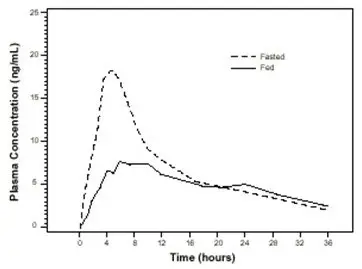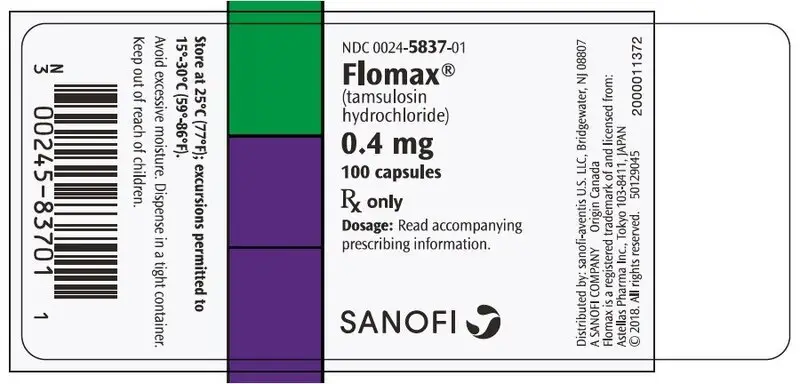Drug Detail:Flomax (Tamsulosin [ tam-soo-loe-sin ])
Drug Class: Alpha-adrenoreceptor antagonists
Highlights of Prescribing Information
FLOMAX ® (tamsulosin hydrochloride, USP) capsules, for oral use
Initial U.S. Approval: 1997
Indications and Usage for Flomax
- FLOMAX is an alpha 1 adrenoceptor antagonist indicated for treatment of the signs and symptoms of benign prostatic hyperplasia ( 1)
- FLOMAX capsules are not indicated for the treatment of hypertension ( 1)
Flomax Dosage and Administration
- 0.4 mg once daily taken approximately one-half hour following the same meal each day. FLOMAX capsules should not be crushed, chewed or opened. ( 2)
- Can be increased to 0.8 mg once daily for patients who fail to respond to the 0.4 mg dose after 2 to 4 weeks of dosing ( 2)
- If discontinued or interrupted for several days, therapy should start again with the 0.4 mg once-daily dose ( 2)
Dosage Forms and Strengths
- Capsules: 0.4 mg ( 3)
Contraindications
- Contraindicated in patients known to be hypersensitive to tamsulosin hydrochloride or any component of FLOMAX capsules ( 4, 6.2)
Warnings and Precautions
- Advise patients about the possibility of symptoms related to postural hypotension and to avoid situations where injury could result should syncope occur ( 5.1)
- Should not be used in combination with strong inhibitors of CYP3A4. Use with caution in combination with moderate inhibitors of CYP3A4, with strong or moderate inhibitors of CYP2D6, in patients known to be CYP2D6 poor metabolizers, or in combination with other cytochrome P450 inhibitors. ( 5.2, 7.1, 12.3)
- Should not be used in combination with other alpha adrenergic blocking agents ( 5.2, 7.2, 12.3)
- Exercise caution with concomitant administration of warfarin ( 5.2, 7.4, 12.3)
- Advise patients about the possibility and seriousness of priapism ( 5.3)
- Intraoperative Floppy Iris Syndrome has been observed during cataract and glaucoma surgery in some patients. Advise patients considering cataract or glaucoma surgery to tell their ophthalmologist that they have taken FLOMAX capsules. ( 5.5)
- Advise patients to be screened for the presence of prostate cancer prior to treatment and at regular intervals afterwards ( 5.4)
Adverse Reactions/Side Effects
- The most common adverse events (≥2% of patients and at a higher incidence than placebo) with the 0.4 mg dose or 0.8 mg dose were headache, dizziness, rhinitis, infection, abnormal ejaculation, asthenia, back pain, diarrhea, pharyngitis, chest pain, cough increased, somnolence, nausea, sinusitis, insomnia, libido decreased, tooth disorder, and blurred vision ( 6.1)
To report SUSPECTED ADVERSE REACTIONS, contact sanofi-aventis U.S. LLC at 1-800-633-1610 or FDA at 1-800-FDA-1088 or www.fda.gov/medwatch.
Drug Interactions
- FLOMAX capsules 0.4 mg should not be used with strong inhibitors of CYP3A4 (e.g., ketoconazole). FLOMAX capsules should be used with caution in combination with moderate inhibitors of CYP3A4 (e.g., erythromycin), in combination with strong (e.g., paroxetine) or moderate (e.g., terbinafine) inhibitors of CYP2D6, or in patients known to be CYP2D6 poor metabolizers, particularly at a dose higher than 0.4 mg (e.g., 0.8 mg). ( 5.2, 7.1, 12.3)
- Concomitant use of PDE5 inhibitors with tamsulosin can potentially cause symptomatic hypotension ( 5.2, 7.3, 12.3)
Use In Specific Populations
- Pediatric Use: Not indicated for use in pediatric populations ( 8.4, 12.3)
- Geriatric Use: No overall differences in efficacy or safety vs younger patients, but greater sensitivity of some older adults cannot be ruled out ( 8.5, 12.3)
- Renal Impairment: Has not been studied in patients with end-stage renal disease ( 8.6, 12.3)
- Hepatic Impairment: Has not been studied in patients with severe hepatic impairment ( 8.7, 12.3)
See 17 for PATIENT COUNSELING INFORMATION and FDA-approved patient labeling.
Revised: 1/2019
Related/similar drugs
tamsulosin, finasteride, tadalafil, prazosin, Cialis, doxazosinFull Prescribing Information
1. Indications and Usage for Flomax
FLOMAX (tamsulosin hydrochloride, USP) capsules are indicated for the treatment of the signs and symptoms of benign prostatic hyperplasia (BPH) [see Clinical Studies (14)] . FLOMAX capsules are not indicated for the treatment of hypertension.
2. Flomax Dosage and Administration
FLOMAX capsules 0.4 mg once daily is recommended as the dose for the treatment of the signs and symptoms of BPH. It should be administered approximately one-half hour following the same meal each day. FLOMAX capsules should not be crushed, chewed or opened.
For those patients who fail to respond to the 0.4 mg dose after 2 to 4 weeks of dosing, the dose of FLOMAX capsules can be increased to 0.8 mg once daily. FLOMAX capsules 0.4 mg should not be used in combination with strong inhibitors of CYP3A4 (e.g., ketoconazole) [see Warnings and Precautions (5.2)] .
If FLOMAX capsules administration is discontinued or interrupted for several days at either the 0.4 mg or 0.8 mg dose, therapy should be started again with the 0.4 mg once-daily dose.
3. Dosage Forms and Strengths
Capsule: 0.4 mg, olive green and orange hard gelatin, imprinted on one side with Flomax 0.4 mg and on the other side with BI 58.
4. Contraindications
FLOMAX capsules are contraindicated in patients known to be hypersensitive to tamsulosin hydrochloride or any component of FLOMAX capsules. Reactions have included skin rash, urticaria, pruritus, angioedema, and respiratory symptoms [see Adverse Reactions (6.2)].
5. Warnings and Precautions
5.1 Orthostasis
The signs and symptoms of orthostasis (postural hypotension, dizziness, and vertigo) were detected more frequently in FLOMAX capsule-treated patients than in placebo recipients. As with other alpha adrenergic blocking agents there is a potential risk of syncope [see Adverse Reactions (6.1)] . Patients beginning treatment with FLOMAX capsules should be cautioned to avoid situations in which injury could result should syncope occur.
5.2 Drug Interactions
Tamsulosin is extensively metabolized, mainly by CYP3A4 and CYP2D6. FLOMAX capsules 0.4 mg should not be used in combination with strong inhibitors of CYP3A4 (e.g., ketoconazole) [see Drug Interactions (7.1) and Clinical Pharmacology (12.3)] . FLOMAX capsules should be used with caution in combination with moderate inhibitors of CYP3A4 (e.g., erythromycin), in combination with strong (e.g., paroxetine) or moderate (e.g., terbinafine) inhibitors of CYP2D6, in patients known to be CYP2D6 poor metabolizers particularly at a dose higher than 0.4 mg (e.g., 0.8 mg) [see Drug Interactions (7.1) and Clinical Pharmacology (12.3)] .
FLOMAX capsules should be used with caution in combination with cimetidine, particularly at a dose higher than 0.4 mg (e.g., 0.8 mg) [see Drug Interactions (7.1) and Clinical Pharmacology (12.3)] .
FLOMAX capsules should not be used in combination with other alpha adrenergic blocking agents [see Drug Interactions (7.2) and Clinical Pharmacology (12.3)] .
Caution is advised when alpha adrenergic blocking agents including FLOMAX are coadministered with PDE5 inhibitors. Alpha-adrenergic blockers and PDE5 inhibitors are both vasodilators that can lower blood pressure. Concomitant use of these two drug classes can potentially cause symptomatic hypotension [see Drug Interactions (7.3) and Clinical Pharmacology (12.3)] .
Caution should be exercised with concomitant administration of warfarin and FLOMAX capsules [see Drug Interactions (7.4) and Clinical Pharmacology (12.3)] .
5.3 Priapism
Rarely (probably less than 1 in 50,000 patients), tamsulosin, like other alpha 1 antagonists, has been associated with priapism (persistent painful penile erection unrelated to sexual activity). Because this condition can lead to permanent impotence if not properly treated, patients must be advised about the seriousness of the condition.
5.4 Screening for Prostate Cancer
Prostate cancer and BPH frequently coexist; therefore, patients should be screened for the presence of prostate cancer prior to treatment with FLOMAX capsules and at regular intervals afterwards.
5.5 Intraoperative Floppy Iris Syndrome
Intraoperative Floppy Iris Syndrome (IFIS) has been observed during cataract and glaucoma surgery in some patients on or previously treated with alpha 1 blockers, including FLOMAX capsules [see Adverse Reactions (6.2)] .
Most reports were in patients taking the alpha 1 blocker when IFIS occurred, but in some cases, the alpha 1 blocker had been stopped prior to surgery. In most of these cases, the alpha 1 blocker had been stopped recently prior to surgery (2 to 14 days), but in a few cases, IFIS was reported after the patient had been off the alpha 1 blocker for a longer period (5 weeks to 9 months). IFIS is a variant of small pupil syndrome and is characterized by the combination of a flaccid iris that billows in response to intraoperative irrigation currents, progressive intraoperative miosis despite preoperative dilation with standard mydriatic drugs and potential prolapse of the iris toward the phacoemulsification incisions. The patient's ophthalmologist should be prepared for possible modifications to their surgical technique, such as the utilization of iris hooks, iris dilator rings, or viscoelastic substances.
IFIS may increase the risk of eye complications during and after the operation. The benefit of stopping alpha 1 blocker therapy prior to cataract or glaucoma surgery has not been established. The initiation of therapy with tamsulosin in patients for whom cataract or glaucoma surgery is scheduled is not recommended.
6. Adverse Reactions/Side Effects
6.1 Clinical Trials Experience
Because clinical trials are conducted under widely varying conditions, adverse reactions rates observed in the clinical trials of a drug cannot be directly compared to rates in the clinical trials of another drug and may not reflect the rates observed in practice.
The incidence of treatment-emergent adverse events has been ascertained from six short-term U.S. and European placebo-controlled clinical trials in which daily doses of 0.1 to 0.8 mg FLOMAX capsules were used. These studies evaluated safety in 1783 patients treated with FLOMAX capsules and 798 patients administered placebo. Table 1 summarizes the treatment-emergent adverse events that occurred in ≥2% of patients receiving either FLOMAX capsules 0.4 mg or 0.8 mg and at an incidence numerically higher than that in the placebo group during two 13-week U.S. trials (US92-03A and US93-01) conducted in 1487 men.
| BODY SYSTEM/
ADVERSE EVENT | FLOMAX CAPSULES GROUPS | PLACEBO | |
|---|---|---|---|
| 0.4 mg
n=502 | 0.8 mg
n=492 | n=493 | |
|
|||
| BODY AS WHOLE | |||
| Headache | 97 (19.3%) | 104 (21.1%) | 99 (20.1%) |
| Infection † | 45 (9.0%) | 53 (10.8%) | 37 (7.5%) |
| Asthenia | 39 (7.8%) | 42 (8.5%) | 27 (5.5%) |
| Back pain | 35 (7.0%) | 41 (8.3%) | 27 (5.5%) |
| Chest pain | 20 (4.0%) | 20 (4.1%) | 18 (3.7%) |
| NERVOUS SYSTEM | |||
| Dizziness | 75 (14.9%) | 84 (17.1%) | 50 (10.1%) |
| Somnolence | 15 (3.0%) | 21 (4.3%) | 8 (1.6%) |
| Insomnia | 12 (2.4%) | 7 (1.4%) | 3 (0.6%) |
| Libido decreased | 5 (1.0%) | 10 (2.0%) | 6 (1.2%) |
| RESPIRATORY SYSTEM | |||
| Rhinitis ‡ | 66 (13.1%) | 88 (17.9%) | 41 (8.3%) |
| Pharyngitis | 29 (5.8%) | 25 (5.1%) | 23 (4.7%) |
| Cough increased | 17 (3.4%) | 22 (4.5%) | 12 (2.4%) |
| Sinusitis | 11 (2.2%) | 18 (3.7%) | 8 (1.6%) |
| DIGESTIVE SYSTEM | |||
| Diarrhea | 31 (6.2%) | 21 (4.3%) | 22 (4.5%) |
| Nausea | 13 (2.6%) | 19 (3.9%) | 16 (3.2%) |
| Tooth disorder | 6 (1.2%) | 10 (2.0%) | 7 (1.4%) |
| UROGENITAL SYSTEM | |||
| Abnormal ejaculation | 42 (8.4%) | 89 (18.1%) | 1 (0.2%) |
| SPECIAL SENSES | |||
| Blurred vision | 1 (0.2%) | 10 (2.0%) | 2 (0.4%) |
6.2 Postmarketing Experience
The following adverse reactions have been identified during postapproval use of FLOMAX capsules. Because these reactions are reported voluntarily from a population of uncertain size, it is not always possible to reliably estimate their frequency or establish a causal relationship to drug exposure. Decisions to include these reactions in labeling are typically based on one or more of the following factors: (1) seriousness of the reaction, (2) frequency of reporting, or (3) strength of causal connection to FLOMAX capsules.
Allergic-type reactions such as skin rash, urticaria, pruritus, angioedema, and respiratory symptoms have been reported with positive rechallenge in some cases. Priapism has been reported rarely. Infrequent reports of dyspnea, palpitations, hypotension, atrial fibrillation, arrhythmia, tachycardia, skin desquamation including reports of Stevens-Johnson syndrome, erythema multiforme, dermatitis exfoliative, constipation, vomiting, dry mouth, visual impairment, and epistaxis have been received during the postmarketing period.
During cataract and glaucoma surgery, a variant of small pupil syndrome known as Intraoperative Floppy Iris Syndrome (IFIS) has been reported in association with alpha 1 blocker therapy [see Warnings and Precautions (5.5)] .
7. Drug Interactions
7.2 Other Alpha Adrenergic Blocking Agents
The pharmacokinetic and pharmacodynamic interactions between FLOMAX capsules and other alpha adrenergic blocking agents have not been determined; however, interactions between FLOMAX capsules and other alpha adrenergic blocking agents may be expected [see Warnings and Precautions (5.2) and Clinical Pharmacology (12.3)] .
7.3 PDE5 Inhibitors
Caution is advised when alpha adrenergic blocking agents including FLOMAX are coadministered with PDE5 inhibitors. Alpha-adrenergic blockers and PDE5 inhibitors are both vasodilators that can lower blood pressure. Concomitant use of these two drug classes can potentially cause symptomatic hypotension [see Warnings and Precautions (5.2) and Clinical Pharmacology (12.3)] .
7.4 Warfarin
A definitive drug-drug interaction study between tamsulosin hydrochloride and warfarin was not conducted. Results from limited in vitro and in vivo studies are inconclusive. Caution should be exercised with concomitant administration of warfarin and FLOMAX capsules [see Warnings and Precautions (5.2) and Clinical Pharmacology (12.3)] .
7.5 Nifedipine, Atenolol, Enalapril
Dosage adjustments are not necessary when FLOMAX capsules are administered concomitantly with nifedipine, atenolol, or enalapril [see Clinical Pharmacology (12.3)] .
7.6 Digoxin and Theophylline
Dosage adjustments are not necessary when a FLOMAX capsule is administered concomitantly with digoxin or theophylline [see Clinical Pharmacology (12.3)] .
7.7 Furosemide
FLOMAX capsules had no effect on the pharmacodynamics (excretion of electrolytes) of furosemide. While furosemide produced an 11% to 12% reduction in tamsulosin hydrochloride C max and AUC, these changes are expected to be clinically insignificant and do not require adjustment of the FLOMAX capsules dosage [see Clinical Pharmacology (12.3)] .
8. Use In Specific Populations
8.1 Pregnancy
Data
Administration of tamsulosin hydrochloride to pregnant female rats during the period of organogenesis at dose levels up to approximately 50 times the human therapeutic AUC exposure (300 mg/kg/day) revealed no evidence of harm to the fetus. Administration of tamsulosin hydrochloride to pregnant rabbits during the period of organogenesis at dose levels up to 50 mg/kg/day produced no evidence of fetal harm.
8.2 Lactation
FLOMAX is not indicated for use in women. There are no data on the presence of tamsulosin hydrochloride in human milk, the effects of tamsulosin hydrochloride on the breastfed infant, or the effects of tamsulosin hydrochloride on milk production. Tamsulosin hydrochloride is present in the milk of lactating rats [see Data].
8.4 Pediatric Use
FLOMAX capsules are not indicated for use in pediatric populations.
Efficacy and positive benefit/risk of tamsulosin hydrochloride was not demonstrated in two studies conducted in patients 2 years to 16 years of age with elevated detrusor leak point pressure (>40 cm H 2O) associated with known neurological disorder (e.g., spina bifida). Patients in both studies were treated on a weight-based mg/kg schema (0.025 mg, 0.05 mg, 0.1 mg, 0.2 mg, or 0.4 mg tamsulosin hydrochloride) for the reduction in detrusor leak point pressure below 40 cm H 2O. In a randomized, double-blind, placebo-controlled, 14-week, pharmacokinetic, safety and efficacy study in 161 patients, no statistically significant difference in the proportion of responders was observed between groups receiving tamsulosin hydrochloride and placebo. In an open-label, 12-month safety study, 87 patients were treated with tamsulosin hydrochloride. The most frequently reported adverse events (≥5%) from the pooled data of both studies were urinary tract infection, vomiting, pyrexia, headache, nasopharyngitis, cough, pharyngitis, influenza, diarrhea, abdominal pain, and constipation.
8.5 Geriatric Use
Of the total number of subjects (1783) in clinical studies of tamsulosin, 36% were 65 years of age and over. No overall differences in safety or effectiveness were observed between these subjects and younger subjects, and the other reported clinical experience has not identified differences in responses between the elderly and younger patients, but greater sensitivity of some older individuals cannot be ruled out [see Clinical Pharmacology (12.3)] .
10. Overdosage
Should overdosage of FLOMAX capsules lead to hypotension [see Warnings and Precautions (5.1) and Adverse Reactions (6.1)] , support of the cardiovascular system is of first importance. Restoration of blood pressure and normalization of heart rate may be accomplished by keeping the patient in the supine position. If this measure is inadequate, then administration of intravenous fluids should be considered. If necessary, vasopressors should then be used and renal function should be monitored and supported as needed. Laboratory data indicate that tamsulosin hydrochloride is 94% to 99% protein bound; therefore, dialysis is unlikely to be of benefit.
11. Flomax Description
Tamsulosin hydrochloride is an antagonist of alpha 1A adrenoceptors in the prostate.
Tamsulosin hydrochloride is (-)-( R)-5-[2-[[2-( o-Ethoxyphenoxy)ethyl]amino]propyl]-2-methoxybenzenesulfonamide, monohydrochloride. Tamsulosin hydrochloride is a white crystalline powder that melts with decomposition at approximately 230°C. It is sparingly soluble in water and methanol, slightly soluble in glacial acetic acid and ethanol, and practically insoluble in ether.
The empirical formula of tamsulosin hydrochloride is C 20H 28N 2O 5S ∙ HCl. The molecular weight of tamsulosin hydrochloride is 444.98. Its structural formula is:

Each FLOMAX capsule for oral administration contains tamsulosin hydrochloride, USP 0.4 mg, and the following inactive ingredients: microcrystalline cellulose; methacrylic acid copolymer dispersion; triacetin; calcium stearate; talc; gelatin; iron oxide; FD&C blue No. 2; titanium dioxide; propylene glycol; and shellac.
12. Flomax - Clinical Pharmacology
12.1 Mechanism of Action
The symptoms associated with benign prostatic hyperplasia (BPH) are related to bladder outlet obstruction, which is comprised of two underlying components: static and dynamic. The static component is related to an increase in prostate size caused, in part, by a proliferation of smooth muscle cells in the prostatic stroma. However, the severity of BPH symptoms and the degree of urethral obstruction do not correlate well with the size of the prostate. The dynamic component is a function of an increase in smooth muscle tone in the prostate and bladder neck leading to constriction of the bladder outlet. Smooth muscle tone is mediated by the sympathetic nervous stimulation of alpha 1 adrenoceptors, which are abundant in the prostate, prostatic capsule, prostatic urethra, and bladder neck. Blockade of these adrenoceptors can cause smooth muscles in the bladder neck and prostate to relax, resulting in an improvement in urine flow rate and a reduction in symptoms of BPH.
Tamsulosin, an alpha 1 adrenoceptor blocking agent, exhibits selectivity for alpha 1 receptors in the human prostate. At least three discrete alpha 1 adrenoceptor subtypes have been identified: alpha 1A, alpha 1B, and alpha 1D; their distribution differs between human organs and tissue. Approximately 70% of the alpha 1 receptors in the human prostate are of the alpha 1A subtype.
FLOMAX capsules are not intended for use as an antihypertensive drug.
12.2 Pharmacodynamics
Urologic pharmacodynamic effects have been evaluated in neurologically impaired pediatric patients and in adults with BPH [see Use in Specific Populations (8.4) and Clinical Studies (14)] .
13. Nonclinical Toxicology
13.1 Carcinogenesis, Mutagenesis, Impairment of Fertility
Rats administered doses up to 43 mg/kg/day in males and 52 mg/kg/day in females had no increases in tumor incidence, with the exception of a modest increase in the frequency of mammary gland fibroadenomas in female rats receiving doses ≥5.4 mg/kg (P<0.015). The highest doses of tamsulosin hydrochloride evaluated in the rat carcinogenicity study produced systemic exposures (AUC) in rats 3 times the exposures in men receiving the maximum therapeutic dose of 0.8 mg/day.
Mice were administered doses up to 127 mg/kg/day in males and 158 mg/kg/day in females. There were no significant tumor findings in male mice. Female mice treated for 2 years with the two highest doses of 45 and 158 mg/kg/day had statistically significant increases in the incidence of mammary gland fibroadenomas (P<0.0001) and adenocarcinomas (P<0.0075). The highest dose levels of tamsulosin hydrochloride evaluated in the mice carcinogenicity study produced systemic exposures (AUC) in mice 8 times the exposures in men receiving the maximum therapeutic dose of 0.8 mg/day.
The increased incidences of mammary gland neoplasms in female rats and mice were considered secondary to tamsulosin hydrochloride-induced hyperprolactinemia. It is not known if FLOMAX capsules elevate prolactin in humans. The relevance for human risk of the findings of prolactin-mediated endocrine tumors in rodents is not known.
Tamsulosin hydrochloride produced no evidence of mutagenic potential in vitro in the Ames reverse mutation test, mouse lymphoma thymidine kinase assay, unscheduled DNA repair synthesis assay, and chromosomal aberration assays in Chinese hamster ovary cells or human lymphocytes. There were no mutagenic effects in the in vivo sister chromatid exchange and mouse micronucleus assay.
Studies in rats revealed significantly reduced fertility in males dosed with single or multiple daily doses of 300 mg/kg/day of tamsulosin hydrochloride (AUC exposure in rats about 50 times the human exposure with the maximum therapeutic dose). The mechanism of decreased fertility in male rats is considered to be an effect of the compound on the vaginal plug formation possibly due to changes of semen content or impairment of ejaculation. The effects on fertility were reversible, showing improvement by 3 days after a single dose and 4 weeks after multiple dosing. Effects on fertility in males were completely reversed within nine weeks of discontinuation of multiple dosing. Multiple doses of 10 and 100 mg/kg/day tamsulosin hydrochloride (1/5 and 16 times the anticipated human AUC exposure) did not significantly alter fertility in male rats. Effects of tamsulosin hydrochloride on sperm counts or sperm function have not been evaluated.
Studies in female rats revealed significant reductions in fertility after single or multiple dosing with 300 mg/kg/day of the R-isomer or racemic mixture of tamsulosin hydrochloride, respectively. In female rats, the reductions in fertility after single doses were considered to be associated with impairments in fertilization. Multiple dosing with 10 or 100 mg/kg/day of the racemic mixture did not significantly alter fertility in female rats.
14. Clinical Studies
Four placebo-controlled clinical studies and one active-controlled clinical study enrolled a total of 2296 patients (1003 received FLOMAX capsules 0.4 mg once daily, 491 received FLOMAX capsules 0.8 mg once daily, and 802 were control patients) in the U.S. and Europe.
In the two U.S. placebo-controlled, double-blind, 13-week, multicenter studies (Study 1 [US92-03A] and Study 2 [US93-01]), 1486 men with the signs and symptoms of BPH were enrolled. In both studies, patients were randomized to either placebo, FLOMAX capsules 0.4 mg once daily, or FLOMAX capsules 0.8 mg once daily. Patients in FLOMAX capsules 0.8 mg once-daily treatment groups received a dose of 0.4 mg once daily for one week before increasing to the 0.8 mg once-daily dose. The primary efficacy assessments included: 1) total American Urological Association (AUA) Symptom Score questionnaire, which evaluated irritative (frequency, urgency, and nocturia), and obstructive (hesitancy, incomplete emptying, intermittency, and weak stream) symptoms, where a decrease in score is consistent with improvement in symptoms; and 2) peak urine flow rate, where an increased peak urine flow rate value over baseline is consistent with decreased urinary obstruction.
Mean changes from baseline to Week 13 in total AUA Symptom Score were significantly greater for groups treated with FLOMAX capsules 0.4 mg and 0.8 mg once daily compared to placebo in both U.S. studies (Table 3, Figures 2A and 2B). The changes from baseline to Week 13 in peak urine flow rate were also significantly greater for the FLOMAX capsules 0.4 mg and 0.8 mg once-daily groups compared to placebo in Study 1, and for the FLOMAX capsules 0.8 mg once-daily group in Study 2 (Table 3, Figures 3A and 3B). Overall there were no significant differences in improvement observed in total AUA Symptom Scores or peak urine flow rates between the 0.4 mg and the 0.8 mg dose groups with the exception that the 0.8 mg dose in Study 1 had a significantly greater improvement in total AUA Symptom Score compared to the 0.4 mg dose.
| Total AUA Symptom Score | Peak Urine Flow Rate | |||
|---|---|---|---|---|
| Mean Baseline Value | Mean Change | Mean Baseline Value | Mean Change | |
| Week 13: For patients not completing the 13-week study, the last observation was carried forward. | ||||
|
||||
| Study 1 † | ||||
| FLOMAX capsules
0.8 mg once daily | 19.9 ± 4.9
n=247 | -9.6
‡ ± 6.7
n=237 | 9.57 ± 2.51
n=247 | 1.78
‡ ± 3.35
n=247 |
| FLOMAX capsules
0.4 mg once daily | 19.8 ± 5.0
n=254 | -8.3
‡ ± 6.5
n=246 | 9.46 ± 2.49
n=254 | 1.75
‡ ± 3.57
n=254 |
| Placebo | 19.6 ± 4.9
n=254 | -5.5 ± 6.6
n=246 | 9.75 ± 2.54
n=254 | 0.52 ± 3.39
n=253 |
| Study 2 § | ||||
| FLOMAX capsules
0.8 mg once daily | 18.2 ± 5.6
n=244 | -5.8
‡ ± 6.4
n=238 | 9.96 ± 3.16
n=244 | 1.79
‡ ± 3.36
n=237 |
| FLOMAX capsules
0.4 mg once daily | 17.9 ± 5.8
n=248 | -5.1
‡ ± 6.4
n=244 | 9.94 ± 3.14
n=248 | 1.52 ± 3.64
n=244 |
| Placebo | 19.2 ± 6.0
n=239 | -3.6 ± 5.7
n=235 | 9.95 ± 3.12
n=239 | 0.93 ± 3.28
n=235 |
Mean total AUA Symptom Scores for both FLOMAX capsules 0.4 mg and 0.8 mg once-daily groups showed a rapid decrease starting at 1 week after dosing and remained decreased through 13 weeks in both studies (Figures 2A and 2B).
In Study 1, 400 patients (53% of the originally randomized group) elected to continue in their originally assigned treatment groups in a double-blind, placebo-controlled, 40-week extension trial (138 patients on 0.4 mg, 135 patients on 0.8 mg, and 127 patients on placebo). Three hundred twenty-three patients (43% of the originally randomized group) completed one year. Of these, 81% (97 patients) on 0.4 mg, 74% (75 patients) on 0.8 mg, and 56% (57 patients) on placebo had a response ≥25% above baseline in total AUA Symptom Score at one year.
Figure 2A: Mean Change from Baseline in Total AUA Symptom Score (0–35) Study 1
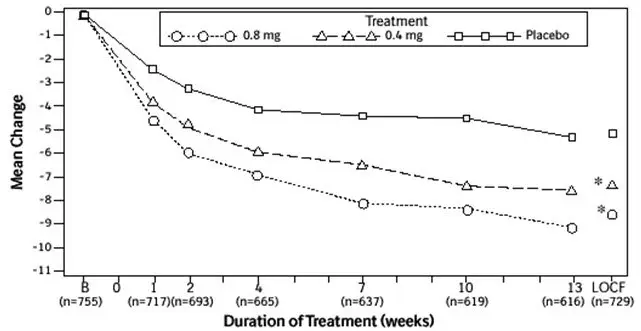
* indicates significant difference from placebo (p-value ≤0.050).
B = Baseline determined approximately one week prior to the initial dose of double-blind medication at Week 0.
Subsequent values are observed cases.
LOCF = Last observation carried forward for patients not completing the 13-week study.
Note: Patients in the 0.8 mg treatment group received 0.4 mg for the first week.
Note: Total AUA Symptom Scores range from 0 to 35.
Figure 2B: Mean Change from Baseline in Total AUA Symptom Score (0–35) Study 2

* indicates significant difference from placebo (p-value ≤0.050).
Baseline measurement was taken Week 0. Subsequent values are observed cases.
LOCF = Last observation carried forward for patients not completing the 13-week study.
Note: Patients in the 0.8 mg treatment group received 0.4 mg for the first week.
Note: Total AUA Symptom Scores range from 0 to 35.
Figure 3A: Mean Increase in Peak Urine Flow Rate (mL/Sec) Study 1
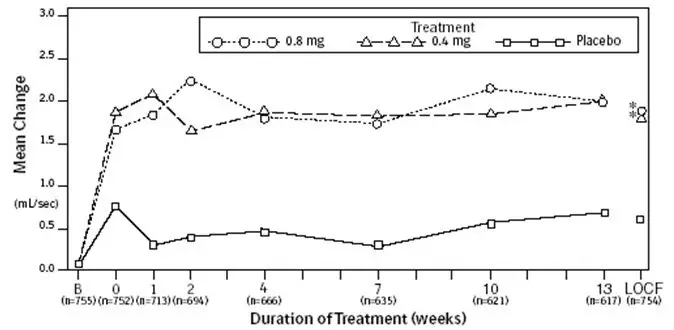
* indicates significant difference from placebo (p-value ≤0.050).
B = Baseline determined approximately one week prior to the initial dose of double-blind medication at Week 0.
Subsequent values are observed cases.
LOCF = Last observation carried forward for patients not completing the 13-week study.
Note: The uroflowmetry assessments at Week 0 were recorded 4 to 8 hours after patients received the first dose of double-blind medication.
Measurements at each visit were scheduled 4 to 8 hours after dosing (approximate peak plasma tamsulosin concentration).
Note: Patients in the 0.8 mg treatment groups received 0.4 mg for the first week.
Figure 3B: Mean Increase in Peak Urine Flow Rate (mL/Sec) Study 2
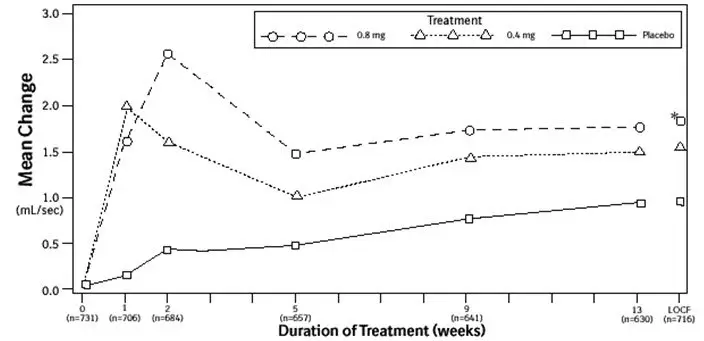
* indicates significant difference from placebo (p-value ≤0.050).
Baseline measurement was taken Week 0. Subsequent values are observed cases.
LOCF = Last observation carried forward for patients not completing the 13-week study.
Note: Patients in the 0.8 mg treatment group received 0.4 mg for the first week.
Note: Week 1 and Week 2 measurements were scheduled 4 to 8 hours after dosing (approximate peak plasma tamsulosin concentration).
All other visits were scheduled 24 to 27 hours after dosing (approximate trough tamsulosin concentration).
16. How is Flomax supplied
FLOMAX capsules 0.4 mg are supplied in high density polyethylene bottles containing 100 hard gelatin capsules with olive green opaque cap and orange opaque body. The capsules are imprinted on one side with Flomax 0.4 mg and on the other side with BI 58.
FLOMAX capsules 0.4 mg, 100 capsules (NDC 0024-5837-01)
| FLOMAX
tamsulosin hydrochloride capsule |
||||||||||||||||||||||||||||||||
|
||||||||||||||||||||||||||||||||
|
||||||||||||||||||||||||||||||||
|
||||||||||||||||||||||||||||||||
|
||||||||||||||||||||||||||||||||
|
||||||||||||||||||||||||||||||||
|
||||||||||||||||||||||||||||||||
| Labeler - sanofi-aventis U.S. LLC (824676584) |
| Establishment | |||
| Name | Address | ID/FEI | Business Operations |
|---|---|---|---|
| Patheon Puerto Rico, Inc. | 143814544 | manufacture(0024-5837) , label(0024-5837) , pack(0024-5837) , analysis(0024-5837) | |
| Establishment | |||
| Name | Address | ID/FEI | Business Operations |
|---|---|---|---|
| Scinopharm Taiwan Ltd. | 657484726 | api manufacture(0024-5837) | |
| Establishment | |||
| Name | Address | ID/FEI | Business Operations |
|---|---|---|---|
| Sixarp LLC | 016329513 | label(0024-5837) , pack(0024-5837) | |
| Establishment | |||
| Name | Address | ID/FEI | Business Operations |
|---|---|---|---|
| Patheon Inc (TRO) | 240769596 | manufacture(0024-5837) , label(0024-5837) , pack(0024-5837) | |




